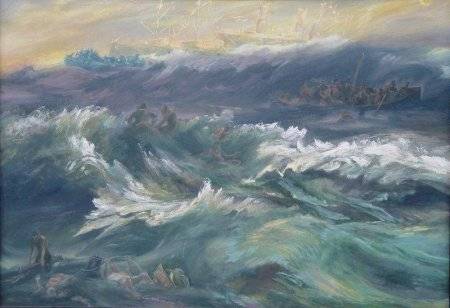The ss Mendi: a ship history forgot
Ninety years ago this morning nearly 650 South African servicemen, on their way to serve in France, died in the English Channel. At 4.57 a.m. on the morning of 21 February 1917 the British mailship Darro collided with the troopship ss Mendi. Such was the damage that the Mendi sustained that by the time my alarm clock went off at 6.30 this morning, the Mendi would already have sunk on that distant morning in 1917, and most of those who’d been aboard her and only hours from their destination in France would already have been dead.

The loss of the Mendi as interpreted by Hilary Graham. Reproduced by courtesy of the Artist and Nelson Mandela Metropolitan Museum of Art
It’s really difficult to guess with any degree of accuracy what those aboard the Mendi must have experienced as the ship foundered and they battled for their lives in the sea. The fear must have been overwhelming.
Most of the black members of the South African Native Labour Corps (SANLC) aboard had no experience of the sea, many probably not even having seen it before they embarked on the Mendi in Cape Town less than 6 weeks before. As a consequence very few could swim. What the men must have felt when it dawned on them that the ship that had protected them from the sea for weeks was doomed, and dying, and that they had no option but to leap into the water is impossible to imagine. Most had been asleep below decks when the collision occurred, and had had to fight their way up onto the deck as water rushed into the holds behind them. How many died, trapped in the holds is unknown.
On deck they were confronted by even more disorientation “the dense fog which had been the cause of the collision“ meant that it was impossible to see more than a few metres, and sounds would have had that curiously muffled quality experienced in fog. Whether they could actually see the sea from the decks where they gathered is also not known, but even if they could the thought of having to spring overboard into an element which for many held a particular terror, must have been an awful experience.
Many refused to leave the vessel, and the story goes that the confused and fearful men were rallied on deck by their chaplain, the Reverend Isaac Dyobha, who called on them to stand together as Africans and die like brothers.
For those who made the leap into the water the shock must have been breathtaking. The water temperature in the Channel at this is time of year is only about 7 degrees Celsius, and so cold that it instantly makes your body ache. I’ve dived in water that cold, and even in a thick wetsuit have suffered. The cold was probably the greatest killer on that foggy morning, and the stories of the survivors tell of men quietly slipping off life rafts as they succumbed to hypothermia.
Rescue efforts were hampered by the dense fog which made finding survivors difficult, but nevertheless more than 200 men were eventually plucked from the water, and saved.
At the time, loss of the Mendi was the single largest catastrophic loss of South African lives and during World War 1 was only eclipsed by the losses that had been suffered by the South African Brigade at Delville Wood on the Western Front in the summer of 1916.
The project Wessex Archaeology is currently undertaking hopes to learn more about the loss of the Mendi, and the Labour Corps system those aboard her were part of aims to make a small contribution to aspects of the story of World War 1 that have been largely ignored and forgotten.
No one who was aboard the Mendi, or who served in the South African Native Labour Corps is still alive today, and the stories of the Mendi, the South African Native Labour Corps and the wider Foreign Labour Corps have now slipped from memory and into history. It’s not too late though to ensure that these forgotten aspects of the ‘war to end wars’ are remembered and understood, and Wessex Archaeology is hoping, through this project and what may follow from it to be able to add something to the story.
I’ll be posting regular updates on this blog as work on the desk-based aspects of the project proceeds, so please log in regularly to check.